- Home
- »
- Consumer F&B
- »
-
Chocolate Market Size, Share & Trends Analysis Report 2030GVR Report cover
![Chocolate Market Size, Share & Trends Report]()
Chocolate Market Size, Share & Trends Analysis Report By Product (Traditional, Artificial), By Distribution Channel (Supermarket & Hypermarket, Convenience Store, Online), By Region, And Segment Forecasts, 2024 - 2030
- Report ID: GVR-4-68038-221-1
- Number of Report Pages: 80
- Format: PDF, Horizon Databook
- Historical Range: 2017 - 2020
- Forecast Period: 2022 - 2030
- Industry: Consumer Goods
Chocolate Market Size & Trends
The global chocolate market size was estimated at USD 119.39 billion in 2023 and is anticipated to grow at a compound annual growth rate (CAGR) of 4.1% from 2024 to 2030. Consumer consciousness regarding the health benefits of eating high-quality chocolate, remains the key driver of the market. Another factor driving product demand in the coming years is the growing demand for vegan, organic, gluten-free, and sugar-free chocolates. The COVID-19 pandemic moderately impacted the global market. Governments across the globe were forced to impose lockdowns due to the rapid spread of infection, forcing many businesses and production facilities to shut down temporarily. This affected the global supply and distribution chain thereby negatively impacting the market growth. However, the demand for chocolates increased during the pandemic as people stocked up on packaged and processed foods. According to the State of Treating Report 2021 by the National Confectioners Association (NCA), chocolate rose by 4.2% during the pandemic period in 2020.
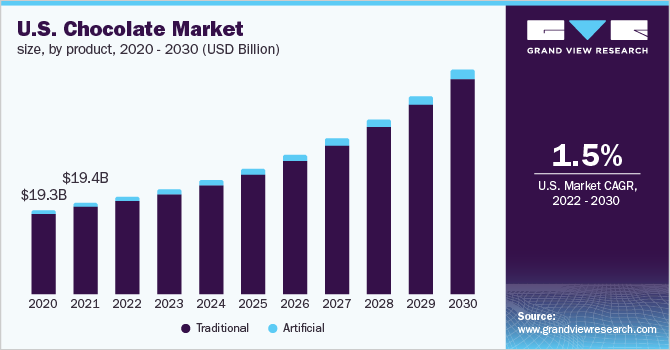
Moreover, consumers preferred eating these during the pandemic to reduce stress and elevate their mood. This ensured a stable demand for chocolates during the pandemic. Consumers' increased belief in the superiority of bean and single-origin chocolates over bar chocolates is anticipated to motivate market participants to invest in the trend to increase their profits. The growing emphasis on the bean-to-bar concept has resulted in a significant increase in demand for premium and specialty chocolate products in recent years. The single-origin cocoa trend is still fueling new product development and innovation. This is expected to contribute to the overall market growth in the coming years.
According to health experts, moderate chocolate consumption increases serotonin, which calms the brain and works as an antidepressant. It also causes the release of endorphins in the body, which quickly improves mood. As per World Population Review data, almost 3.4% or 251-310 million of the global population suffers from depression. Therefore, the rising prevalence of mental illnesses such as anxiety and depression may promote product demand during the forecast period.
Chocolate consumption also reduces the release of the stress hormone named cortisol. Regular inclusion of these elements in a regular diet can mitigate health issues and help avoid reliance on medication. Chocolate sales are expected to increase in the coming years due to its ability to relax the mind and induce happiness. Increasing awareness regarding preventive healthcare is anticipated to further fuel market growth during the projected timeframe.
Another factor influencing the global market is the growing awareness of the health benefits of dark chocolate consumption. According to the Cleveland Clinic, dark chocolate is known to enhance blood circulation in the body, reduce blood pressure, improve brain function, and lower the risk of heart disease when consumed in moderation as it has vital minerals such as zinc, magnesium, phosphorus, copper, and iron. Moreover, some of the factors expected to drive the market growth include the premiumization of chocolate-based products and the use of visually appealing packaging to attract consumers' attention.
Market Concentration & Characteristics
The chocolate market is being driven by several factors, including the increasing demand for premium and high-quality chocolate products, the growing popularity of dark chocolate due to its health benefits, and the rising consumer preference for organic and sustainable chocolate products. Additionally, the innovation in flavors and product varieties, as well as the expansion of the chocolate industry in emerging markets, are contributing to the growth of the chocolate market.
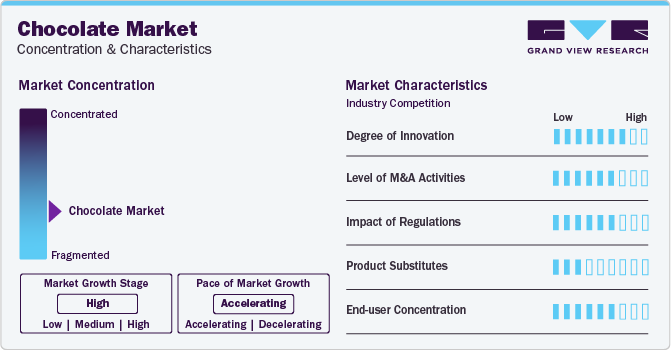
The use of chocolate in various food and beverage applications, such as bakery products, confectionery, and beverages, is contributing to the expansion of the market. Additionally, the increasing awareness about the health benefits of consuming dark chocolate and the development of new distribution channels are influencing the growth of the chocolate market.
Product Insights
The traditional chocolate market dominated the global revenues with a share of over 99% in 2023. This can be attributed to cocoa's greater popularity, ease of availability, and penetration when compared to carob which is the raw material for artificial chocolate. The milk chocolate segment held the largest share in the traditional segment. It contains a high concentration of flavonoids, which are antioxidants that remove free radicals from the bloodstream and improve blood flow. The demand for milk chocolate has increased globally as a result of these advantages, as well as rising consumer purchasing power.
The artificial chocolate market is projected to grow at a CAGR of 9.4% from 2024 to 2030. Carob confectionery is caffeine-free, making it ideal for caffeine-intolerant consumers. According to Caffeine Informer, almost 10% of the global population has hyposensitivity towards caffeine. Furthermore, the calcium composition of carob is almost three times that of cocoa. This makes it especially prevalent among people suffering from calcium deficiency and women.
Despite having to be imported, Nutella from Ferrero India continues to dominate the Indian chocolate spreads market. Globally, they continue to pursue a dominant position in the chocolate confectionery market, as indicated by their launch of Nutella biscuits in 2020, witnessing sales of over 45 million.
Distribution Channel Insights
The online distribution channel is expected to grow at the fastest CAGR of 5.0% from 2024 to 2030. The online channel has gained traction in the last few years due to increased internet penetration in countries globally. The growing internet user population, availability of a variety of brands, and convenience of buying from home are the major factors promoting the use of online distribution channels. Furthermore, features provided by online retailers including cash on delivery, discounts, and cashback are anticipated to boost the growth of online distribution channels.
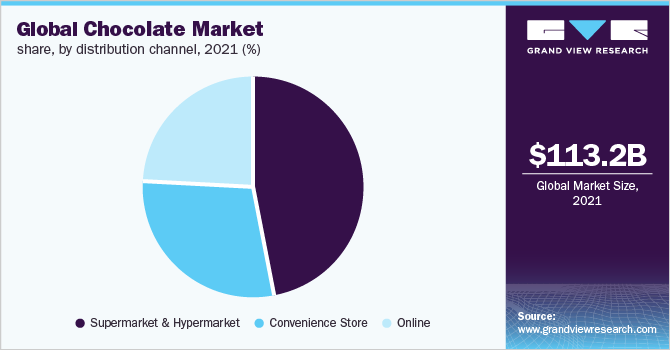
Supermarkets and hypermarkets led the distribution channel segment with a revenue share of over 46.84% in 2023. Higher brand and product availability in such stores is a key factor in the segment's growth. Furthermore, consumers prefer physical stores to get immediate access to the product as well as select the products in person for a better experience. Additionally, due to increasing consumer demand, manufacturers are opening stores in malls, which will increase sales of chocolate in supermarkets and hypermarkets in the upcoming years.
Regional Insights
The Europe chocolate market accounted for a share of 47.41% of the global revenues in 2023. Rising consumer demand for dark chocolate in the region is a major driver of regional market growth. According to ITC Trade Map 2020 data, Europe imported almost 1,521 thousand tons of chocolate products. Furthermore, Europe was also the largest chocolate-producing region with the highest per capita consumption estimated to be 5.0 kilograms as per CBI, Ministry of Foreign Affairs. These factors are predicted to boost the regional market in the coming years.
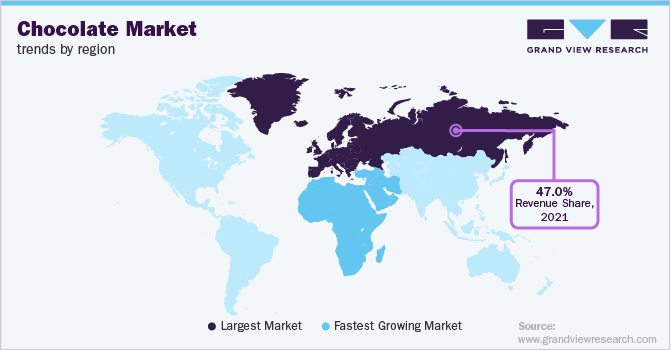
The Middle East and Africa chocolate market is expected to grow at the fastest CAGR of 7.0% from 2024 to 2030. This growth is attributable to the increased availability of products in retail stores in the region. Additionally, the region should have more access to products owing to supportive government policies such as tax benefits for chocolate producers and grinders. Increasing demand for artisanal chocolates is another factor contributing to regional growth. Moreover, rising consumer awareness, product innovation, disposable incomes among middle-class consumers, and channel development by manufacturers to reach a wider consumer base are some of the major factors expected to boost the region's chocolate sales.
The chocolate market in North America is growing at a CAGR of 1.9% from 2024 to 2030 owing to the growing consumer demand for premium and specialty chocolates, the increasing popularity of dark chocolate due to its health benefits, and the rise in demand for organic and ethically sourced chocolates.
Chocolate market in Canada
The growing demand for premium and artisanal chocolates, increasing consumer awareness about the health benefits of dark chocolate, and the rising popularity of organic and fair-trade chocolate products. Additionally, innovative product launches, unique flavor combinations, and the expansion of online retail channels are contributing to the growth of the chocolate market in Canada.
Chocolate market in Mexico
The market is driven by several factors, including the country's rich history and tradition of cacao cultivation, the growing demand for high-quality and organic chocolate products, and the increasing popularity of Mexican chocolate in international markets. Additionally, the rise of bean-to-bar chocolate makers, innovative flavor combinations, and the promotion of Mexican chocolate as a gourmet product are contributing to the growth of the chocolate market in Mexico.
Chocolate market in India
The rising demand for premium and artisanal chocolates, as well as the influence of Western culture and changing consumer preferences, are contributing to the growth of the chocolate market in India. Furthermore, the expansion of retail channels, such as supermarkets and online platforms, has made chocolates more accessible to consumers across the country. These factors combined have led to a significant increase in the consumption of chocolates in India.
Key Chocolate Company Insights
Major companies in the global market focus on new product development to cater to the changing preferences of consumers. Furthermore, industry participants engage in strategic partnerships, mergers, joint ventures, and geographic expansion to gain a competitive edge in the market.
Key Chocolate Companies:
The following are the leading companies in the chocolate market. These companies collectively hold the largest market share and dictate industry trends. Financials, strategy maps & products of these chocolate companies are analyzed to map the supply network.
- Barry Callebaut
- Chocoladefabriken Lindt & Sprüngli AG
- Mondelēz International, Inc.
- Nestlé
- The Hershey Company
- Ferrero Group
- Mars, Incorporated
- The Australian Carob Co.
- Meiji Holdings Co., Ltd.
- Arcor
Recent Developments
-
In October 2023, Mondelēz International is repositioned the Toblerone chocolate brand as a premium chocolate with its "Never Square" campaign. The campaign takes inspiration from luxury brands and positions Toblerone as a unique and high-quality chocolate. To support the new brand positioning, Toblerone is introducing innovative formats and gifting options, including Toblerone Truffles with a velvety smooth truffle center and a unique diamond shape. The brand is also expanding its Tiny Toblerone packs to U.S. retailers, making the chocolate more accessible. These smaller sizes and shareable packs align with the company's goal of providing a variety of portion sizes and mindful snacking options.
-
In October 2022, Barry Callebaut, a leading manufacturer of high-quality chocolate and cocoa products, announced the development of the second generation of chocolate. This new chocolate places a greater emphasis on cocoa and reduces the amount of sugar used. The Cocoa Cultivation & Craft principle is employed in creating this new generation of chocolate, which aims to highlight the unique flavors of each cocoa bean. The result is chocolate that contains 60-80% more cocoa and 50% less sugar, making it a healthier option for those looking for a mindful indulgence.
-
In January 2021, Mars Inc. launched two new vegan chocolates terming the month as ‘Veganuary’ wherein most people commit to consuming only a vegan diet. The two new chocolate bars are the vegan versions of Topic and Bounty and are named Topic Vegan and Bounty Vegan. The company had also launched a vegan version of Galaxy chocolate previously.
Chocolate Market Report Scope
Report Attribute
Details
Market size value in 2024
USD 123.05 billion
Revenue forecast in 2030
USD 156.74 billion
Growth rate (Revenue)
CAGR of 4.1% from 2024 to 2030
Actuals
2018 - 2023
Forecast period
2024 - 2030
Quantitative units
Revenue in USD million, and CAGR from 2024 to 2030
Report coverage
Revenue forecast, company ranking, competitive landscape, growth factors, and trends
Segments covered
Product, distribution channel, region
Regional scope
North America; Europe; Asia Pacific; Central & South America; Middle East & Africa
Country scope
U.S., Canada, Mexico, UK, Germany, Switzerland, France, Italy, Spain, China, India, Japan, Australia, South Korea, Brazil, Argentina, UAE, South Africa
Key companies profiled
Barry Callebaut; Chocoladefabriken Lindt & Sprüngli AG; Mondelēz International, Inc.; Nestlé; The Hershey Company; Ferrero Group; Mars Incorporated, The Australian Carob Co.; Meiji Holdings Co., Ltd.; Arcor
Customization scope
Free report customization (equivalent up to 8 analysts working days) with purchase. Addition or alteration to country, regional & segment scope. Pricing and purchase options
Avail customized purchase options to meet your exact research needs. Explore purchase options Global Chocolate Market Segmentation
This report forecasts revenue growth at the global, regional, and country levels and provides an analysis of the latest industry trends and opportunities in each of the sub-segments from 2018 to 2030. For the purpose of this study, Grand View Research has segmented the global chocolate market report on the basis of product, distribution channel, and region:
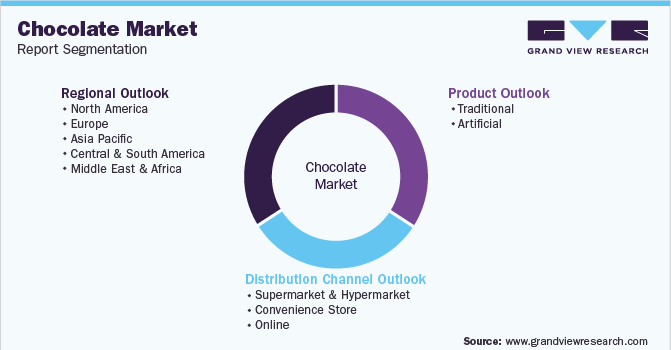
-
Product Outlook (Revenue, USD Million, 2018 - 2030)
-
Traditional
-
Dark
-
Milk
-
White
-
-
Artificial
-
-
Distribution Channel Outlook (Revenue, USD Million, 2018 - 2030)
-
Supermarket & Hypermarket
-
Convenience Store
-
Online
-
-
Regional Outlook (Revenue, USD Million, 2018 - 2030)
-
North America
-
U.S.
-
Canada
-
Mexico
-
-
Europe
-
Germany
-
U.K.
-
Switzerland
-
France
-
Italy
-
Spain
-
-
Asia Pacific
-
China
-
India
-
Japan
-
Australia
-
South Korea
-
-
Central & South America
-
Brazil
-
Argentina
-
-
Middle East & Africa
-
UAE
-
South Africa
-
-
Frequently Asked Questions About This Report
b. The global chocolate market size was estimated at USD 113.16 billion in 2021 and is expected to reach USD 116.11 billion in 2022.
b. The global chocolate market is expected to grow at a compound annual growth rate of 3.7% from 2022 to 2030 to reach USD 156.74 billion by 2030.
b. Europe dominated the chocolate market with a share of 47.6% in 2021. This is attributable to the region's rising consumer demand for dark chocolate.
b. Key players in the chocolate market include Barry Callebaut, Chocoladefabriken Lindt & Sprüngli AG, Mondelēz International, Inc., Nestlé, The Hershey Company, Ferrero Group, Mars, Incorporated, The Australian Carob Co., Meiji Holdings Co., Ltd., Arcor.
b. Key factors driving the market growth include increasing demand for high-quality chocolate and growing consumption of dark chocolate.
Share this report with your colleague or friend.
![gvr icn]()
NEED A CUSTOM REPORT?
We can customize every report - free of charge - including purchasing stand-alone sections or country-level reports, as well as offer affordable discounts for start-ups & universities. Contact us now
![Certified Icon]()
We are GDPR and CCPA compliant! Your transaction & personal information is safe and secure. For more details, please read our privacy policy.
We are committed towards customer satisfaction, and quality service.
"The quality of research they have done for us has been excellent."





